Thinning hairlines and obvious bald spots have plagued elderly men through the years, and science might have finally found the cure—albeit in a fairly unusual way.
A group of scientists hired by cosmetics giant L’Oreal has teamed up with Poietis, a French bioprinting company, in an attempt to print living human hair follicles.
Through the use of a state-of-the-art laser, follicles could be implanted in a patient’s head which would then produce a biological tissue that could sprout new hair, a Mirror report said.
The follicles, which contains living cells of the patient’s own hair, would then be printed using a specialized “ink,” composed of cells from alopecia patients, produced after hair surgery.
José Cotovio, director of predictive methods and models at L’Oréal, described their pioneering technique as a “cure for millions of hair loss sufferers.”
“This is the holy grail that we all have in mind to make something to put on the head of people with hair-loss problems,” he was quoted as saying in the report.
“Hair loss is a very emotional problem for people, and this is the final target, but we get there step by step. We think this is the time. We have the knowledge and the technology,” he added.
The L’Oréal executive also explained that their new findings could position biological tissue and produce an extremely impressive cellar resolution of over 95 percent.
“For L’Oréal, the combination of our respective areas of expertise opens up the possibility of previously unheard of achievements in the field of hair,” he said.
Despite their recent findings, researchers admitted that current tissue engineering techniques are still limited in terms of matching cell patterns.
The tissue created must also enter a three-week maturation process before it can be used in tests, but the two companies are optimistic that they could crack the process very soon.
“We know it is very difficult to do; we know a lot of teams have tried,” Cotovio said. “But we think by reproducing this very complicated hair follicle we will acquire new knowledge and it will help us understand the mysteries of hair loss and aging.”
His colleague, Fabien Guillemot, chief scientific officer at Poietis, echoed his sentiments, while also acknowledging the difficult process.
“A hair follicle is a very small organ, half a millimeter across. We have to get everything right to have a hair grow at the end,” he said.
According to a recent study, 30 percent of men under the age of 30 suffer from early signs of baldness, and this rises to 80 percent for those in their 70s. The statistics, however, may vary among different races. Khristian Ibarrola
